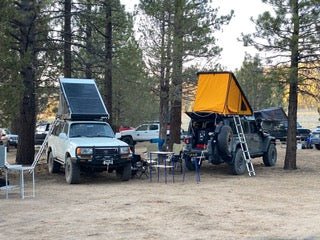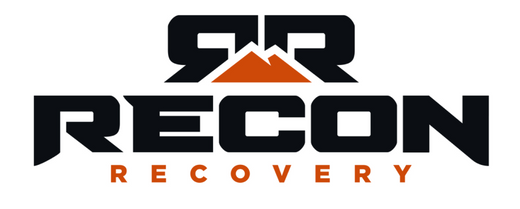
Essential Gear For Overlanding
Narrowing down the gear you NEED to have when exploring the backcountry.

- Vehicle

By far, the most important choice you have to make in regard to gear is what vehicle to start with. Whether you are looking at a car-based SUV or a body-on-frame truck, there are some things that every adventure vehicle should have in common. When choosing a base vehicle, we look for increased ground clearance, robust recovery points, underbody protection, a mechanical or electronic traction control system, good off-road range, and ample payload. We also consider things such as the weight rating of the roof and how much aftermarket support there is for adding more use-specific upgrades. The worst thing that you can do is to choose a vehicle that you put time and money into building, only to quickly outgrow the platform as your skill level and confidence increases.
- Shelter
Next on our list is a proper shelter for the weather and intended activity. Shelters can be anything from one-person bivy-style ground tents, or sky-high rooftop tents, all the way up to multi-room family-sized tents. Tents can be rated for summer or be fully insulated for winter and many of these tents include the option to add an awning or annex to extend your outdoor living space. Some people will even drag a specialty trailer off-road for a fully equipped, self-contained shelter experience.
- Sleeping
Nothing can ruin a trip like a bad night of sleep. We always recommend an appropriately temperature-rated sleeping bag or camping quilt, and for those not sleeping on a mattress in their rooftop tent, a camping pad or mattress can make sleeping outdoors as comfortable as your bed at home. Camping pads typically support the body with air, foam, or sometimes both. Pillows can also make a huge difference in comfort and if you have enough room to bring your favorite pillow from home, you should. Otherwise, compact camping pillows are available.
- First Aid

Self-sufficiency demands that one be able to tend to any injuries, big or small. A well-stocked first aid kit that can handle both ends of the injury spectrum is ideal and there are many companies that sell kits catered to the adventuring market, specifically overlanding. When researching first aid kits, find one that comes in a durable case that is well organized and well-marked. In addition to carrying all the items that can tend to a wound, it is good to also stock up on popular medications, such as aspirin, antibiotics, and cleansing wipes.
- Fire Extinguisher

Fire is the one thing no one wants to think about, but having a fire on the trail could quickly become a life-threatening emergency. We like to carry eco-friendly, no-mess fire extinguishers, such as the ones that use the Halotron chemical. Advantages to Halotron includes no leftover residue after discharging that could damage vehicle finishes or vehicle components and it won’t temperature shock or damage electronics. Also consider carrying a fire extinguisher that can put out an errant cooking or camp fire. Any fire extinguisher needs to be positioned so that it is readily available in case of emergency.
- Recovery
At minimum, all off-roaders should carry a basic recovery kit that can be used with another vehicle to recover a stuck rig. These kits typically include a couple of shackles and a strap, while more complete kits will include a dynamic rope, gloves, soft shackles, and even a snatch block for use with a winch. Winches should be chosen based on 1.5 times your maximum loaded weight, and nothing less. When no one else is around your options may be limited and you might consider a winch anchor or even traction boards for getting unstuck when you are rolling solo.
- Hygiene
Whether you are planning on a quick towel bath, using one of the single-use wipe products on the market, or setting up a full camp shower, hygiene is important for staying comfortable out in the backcountry. Good hygiene can make you feel more energized and can prevent infection from setting in on small cuts and scrapes.
- Tools
One thing is for sure, things happen off-road and you should always be prepared to handle whatever comes your way. Every off-road rig should have a flashlight, knife, multi-tool, and a basic tool set. We recommend starting with one of the many pre-existing tool kits available, supplementing with your own vehicle specific tools. Multi-tools are great for minor repairs, while an LED headlamp could be a huge help if you are solo and need to keep your hands free. We also recommend tools, such as shovels, axes, and picks, especially ones that use a single handle that can accept a variety of toolheads. These types of tools save space and weight and can be used for multiple tasks, such as trail repairs or clearing foliage.
- Food and Water
Out on the trail, sustenance can come in many forms. Some prefer a protein bar or freeze-dried food and a Jet Boil, while others have a full-on portable fridge and camp kitchen worthy of gourmet meals. There is no right answer when it comes to keeping yourself fed. While a 12-volt fridge can be a game changer, a quality cooler can accomplish the same goal for much less. We also suggest a ruggedized container for storing water to prevent any errant punctures that could jeopardize your valuable water supply.
Shop Coolers and Refrigerators
- On-board Air

Airing your tires down provides better traction and increased ride compliance off-road, but it also necessitates a way to air your tires back up before you hit the road. On-board air is a critical component of back country travel and can be used to activate air lockers, re-seat a bead, air up your tires, blow dust from vehicle components, like an air filter, or air up a slow leak until you can get to a place to repair or replace the tire. With a quality pump and a storage tank, or a CO2 system, on-board air can even be used to run air tools.
- Communication

Not every place you may roam has a cell signal, so whether you are alone or in a group, communication is a vital capability in the backcountry. HAM or GMRS are great platforms for traveling in groups and communicating from car to car. These radio platforms are also good for those folks who travel alone because both have the ability to access repeaters and extend the radio’s transmission range. Another communication platform worth exploring is the variety of satellite communicators on the market. For those times when there is no cell signal and a radio isn’t enough, these satellite communicators can send text messages to contacts without an active cellular connection and even summon help at the press of an SOS button.






